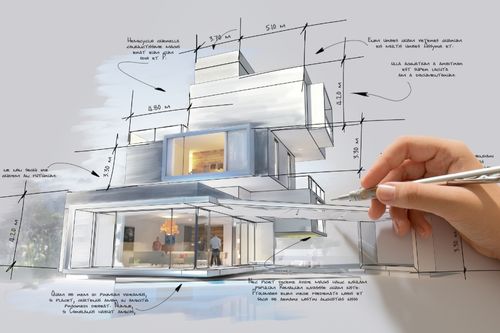Comprehending the Collaborative Process In Between Designers and Engineers in Modern Building Projects
The joint process in between architects and engineers is essential in contemporary building and construction jobs, as it harmonizes design intent with engineering expediency. Discovering these dynamics reveals understandings that could significantly impact task end results and general industry standards.
The Significance of Cooperation
The joint synergy between designers and designers is crucial for the effective understanding of any kind of building project. This partnership brings together distinct competence and viewpoints, making it possible for the integration of ingenious layout with sensible engineering remedies. By interacting, engineers and designers can guarantee that a task not just meets aesthetic and useful requirements yet additionally sticks to security, sustainability, and financial constraints.
Cooperation fosters a common vision, promoting the alignment of objectives and assumptions from the outset. This positioning is important in attending to potential challenges and mitigating threats that could arise throughout the task lifecycle. A collective strategy allows for the reliable allocation of resources, maximizing both time and cost.
The importance of collaboration includes the repetitive process of design and construction, where feedback from designers can notify building choices, causing more possible and lasting designs. Conversely, engineers can motivate designers to assume artistically concerning just how to attain structural stability without compromising artistic intent. Inevitably, the collective partnership between architects and engineers is not just helpful; it is essential to the creation of premium, practical, and innovative constructed atmospheres that meet the needs of society.
Interaction Techniques and Devices
Reliable communication strategies and tools are vital for fostering partnership in between engineers and designers throughout the project lifecycle. Developing clear networks of interaction is necessary to make sure that all team members are aligned with project objectives, timelines, and obligations. Routine conferences, both in-person and digital, supply opportunities for stakeholders to talk about progress, address issues, and make notified choices.
Using job monitoring software application, such as BIM (Building Information Modeling) systems, enhances collaboration by making it possible for real-time sharing of style modifications and technological requirements. These devices promote openness, allowing engineers and engineers to envision modifications and examine their effect on the general job.

Shared Objectives and Task Vision

Developing common goals includes open dialogue and a detailed understanding of each discipline's contributions. Engineers commonly concentrate on style intent, spatial connections, and user experience, while designers highlight structural integrity, systems functionality, and compliance with regulations (cda architects). When these point of views are aligned, the outcome is a natural project that abides by both imaginative ambitions and technological expediency
In addition, a well-defined task vision cultivates accountability among team members, motivating each individual to take ownership of their role in attaining the wanted result. Normal check-ins and joint workshops can additionally enhance this dedication, enabling modifications to be made as the task develops. Inevitably, a shared vision not just enhances teamwork however additionally raises the top quality of the last deliverable, bring about effective project conclusion.
The Function of Innovation
Leveraging technology has actually ended up being her comment is here crucial in improving collaboration between engineers and engineers. Structure Info Modeling (BIM) stands out as an essential technology, permitting both architects and engineers to produce comprehensive 3D models that envelop design intent and structural stability.
Moreover, cloud-based systems allow smooth collaboration, enabling job stakeholders to accessibility and update task data from anywhere. This promotes a culture of openness and responsibility, as adjustments can be tracked and examined in real-time. In addition, mobile applications more boost communication, supplying on-site teams with immediate accessibility to job requirements and updates.
Emerging technologies such as artificial knowledge and machine understanding are likewise starting to contribute in anticipating evaluation, assisting groups determine prospective concerns prior to they occur. Ultimately, the function of modern technology in architecture-engineering cooperation not just enhances operations effectiveness yet also improves advancement, bring about even more effective task outcomes. By accepting these technical improvements, architects and designers can guarantee an extra cohesive and efficient collaborative process throughout the building and construction lifecycle.
Situation Research Studies in Successful Partnerships
Various case researches show the extensive impact of efficient collaborations between designers and designers on task results. One remarkable instance is the partnership on the High Line in New York City, where landscape architects, engineers, and urban planners worked with each other to change a deserted rail line into a vivid public park. This multidisciplinary technique not just boosted the aesthetic top quality but likewise made sure architectural safety and ecological sustainability.
An additional excellent instance is the design and building and construction of the Sydney Opera House. The partnership between designer JÃ ¸ registered nurse Utzon and structural designer Ove Arup exhibited innovative analytic. Their cooperation permitted the renowned shell-like layout while dealing with intricate engineering challenges, eventually causing a classic architectural work of art.
The Burj Khalifa in Dubai even more demonstrates the value of collaborative efforts. cda architects. The integration of style and design proficiency made it possible for the job group to accomplish unmatched elevations while sticking to security policies and aesthetic vision
These instances highlight the value Read Full Article of communication, count on, and shared goals. In today's intricate construction setting, such partnerships are necessary to navigating obstacles and delivering tasks that satisfy both functional and visionary objectives.
Verdict
In final thought, the cooperation between engineers and designers is essential for the success of contemporary building and construction jobs. Reliable communication techniques, a common job vision, and the Recommended Site assimilation of advanced modern technologies are important elements that promote this partnership.
Comments on “Discover Ingenious Layouts with Leading CDA Architects for Your Next Project”